
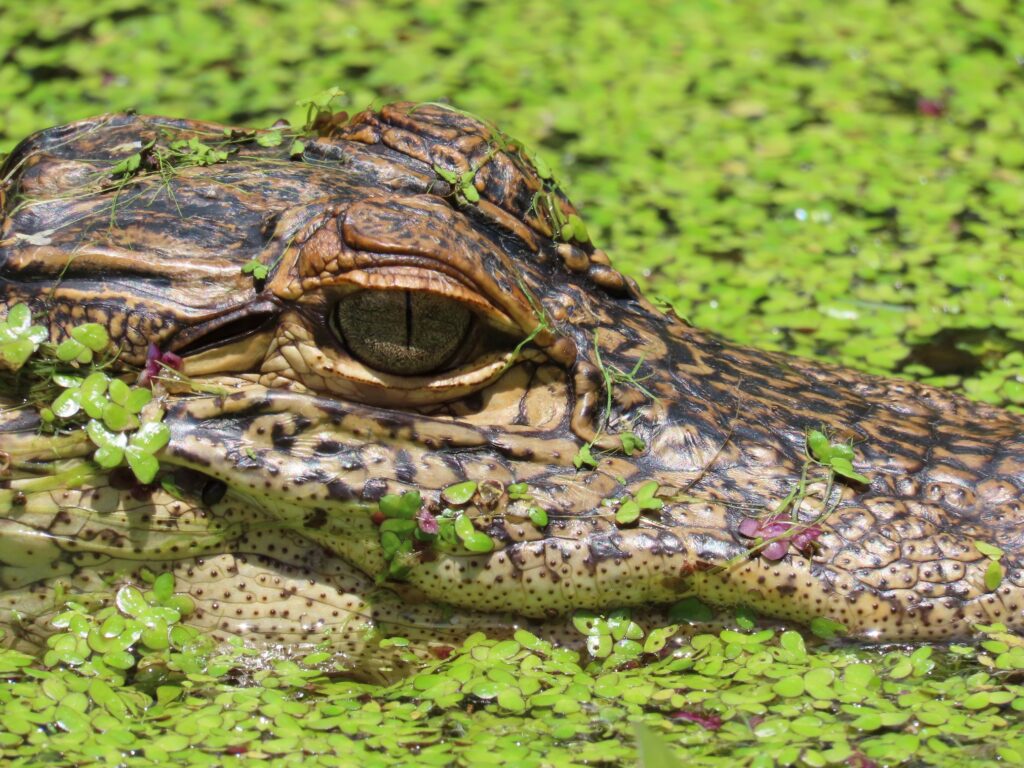
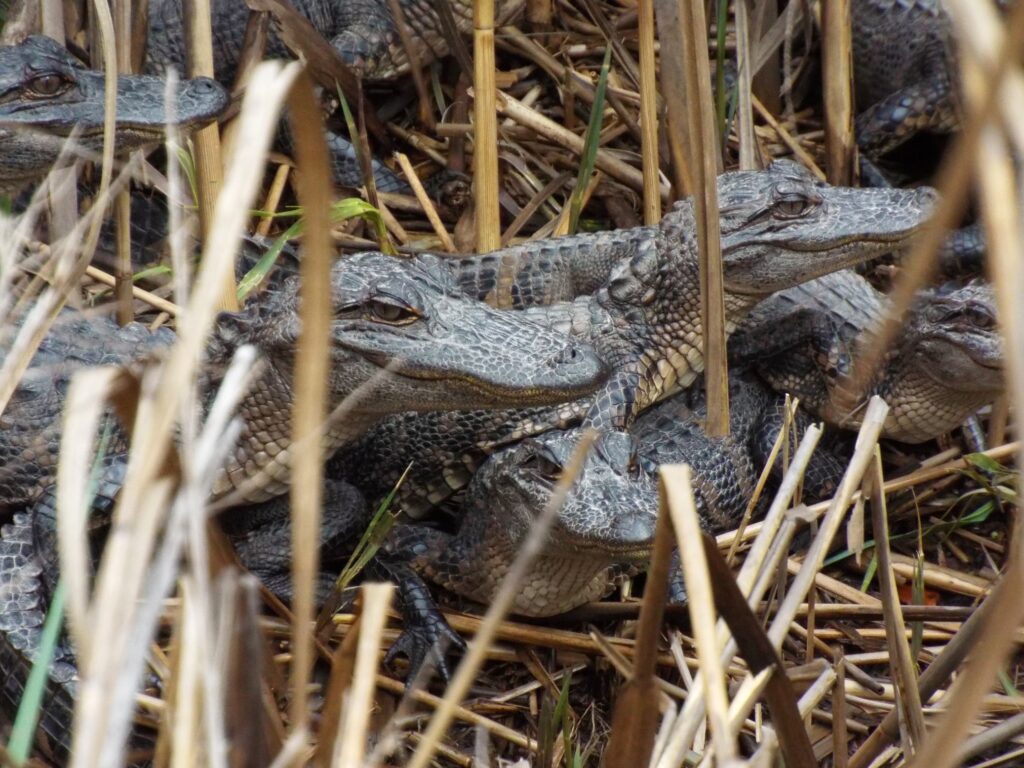
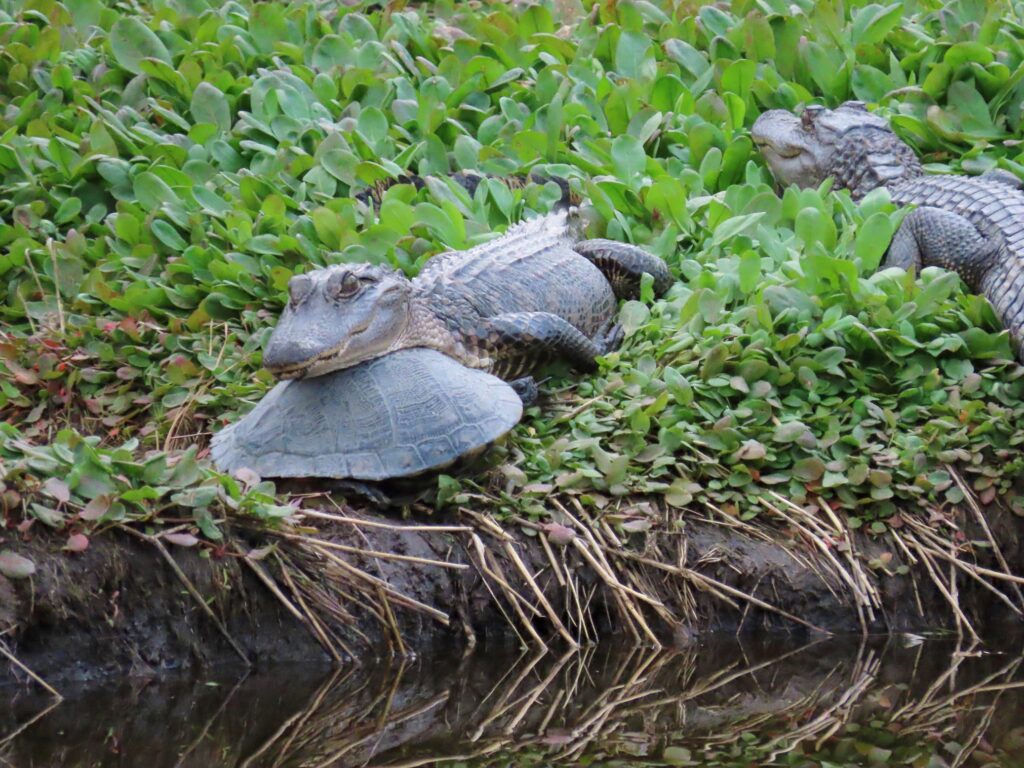
This week for Flora and Fauna Friday we have “the big lizard”, the American Alligator (Alligator mississippiensis).
The American Alligator is not actually a lizard, it’s our only representative of Crocodilians on Edisto. There’s only one other Crocodilian in the United States, the American Crocodile (Crocodylus acutus), which is found exclusively in south Florida. Alligators are found in fresh, brackish, and even saline waters throughout the coastal plain. They have salt glands for removing excess salt from their bodies but they’re not that efficient at it. So they prefer to stick to Freshwater when they can. Alligators are ectotherms and thus rely on heat from the environment to stay warm. They’re primarily nocturnal but are often found basking on the bank in the heat of the day, soaking up the sun to help them digest. They can live over 50 years in the wild and males can reach 15ft in length and weigh half ton. Females are more petite, usually only reaching 8ft in length and 200lbs in weight. Alligators have indeterminate growth, meaning they grow continuously throughout life. American Alligators have one of the strongest bite forces of any animal and they principally use that power to crush turtle shells. Gators are the top of the food chain in South Carolina. They have no natural predators when fully grown, other than Bull Sharks in that one in a million instance where gator and shark cross paths. Despite this position in the pecking order, Alligators mostly eat fish, crabs, and turtles along with the occasional wading bird and Raccoon. Unlike Crocodiles, Alligators rarely go after anything they can’t swallow whole. However, those who tempt fate often find their date with destiny.
Alligators are a keystone species. They dig in the mud underwater to create depressions that hold water during droughts. These gator-made puddles are critical to the survival of fish and amphibians who inhabit shallow wetlands. Old Alligator nests do the reverse, creating dry hills in the swamp where other reptiles can nest and wetland trees and shrubs can take root. Somewhat counter intuitively, they’re the first line of defense for the nests of wading birds, like Egrets, Ibis, and Wood Storks. The single greatest danger to these bird nests are Raccoons. Raccoons love eggs and despite the birds nesting en masse over Gator infested swamps, Raccoons are still willing to make the treacherous swim for heron on the half-shell. Both Alligators and Raccoons are nocturnal and it doesn’t take a rocket-scientist to guess who’ll win that aquatic one-on-one. Although Alligators unintentionally protect fledgling wading birds, they won’t hesitate to make a meal of unlucky birds who fall from the nest.
American Alligators start life as an egg inside a mound of dirt and leaves on the bank of the water. A pile of detritus lovingly constructed by their mother. When the baby gators hatch, they begin calling for mama, who is most often lurking nearby. Mother Alligators protect their young for the first year or two of life. Baby gators feed on minnows, frogs, crawfish, and insects, transitioning to larger prey with age. Males can be quite territorial with each other. Mature bull gators (I believe the technical term is “big boys”) are known to kill, and subsequently eat, smaller males they find in their territory. This forces adolescent Alligators to flee to far off puddles in late spring to avoid predation. That’s why small Alligators seem to spontaneously crop up all over the Lowcountry every June. Bull gators court females with a bellow display. He floats with his back just below the surface of a glassy mire and forcefully exhales through his throat with a resonant, bassy growl that vibrates his entire body. This bellowing vibrato shakes the water around him, creating energetic ripples across its surface and presumably wooing the object of his affection.
Alligators are another conservation success story. Since Europeans first arrived in the Americas, native predators have been persecuted relentlessly. Wolves and Cougars were extirpated from the state, Black Bears nearly were, and Alligators were following suit. The Alligator’s only saving grace was their preference for inaccessible swampy habitat. However, even those murky havens were not safe from lumbering, draining, and filling. With the introduction of the endangered species act, the American Alligator was given a second chance. Because of their association with rookeries, the recovery of the American Alligator went hand in hand with that of the Wood Stork. Nowadays, with how thick our wetlands are with gators, you can scarcely imagine that the species was once so close to the brink!
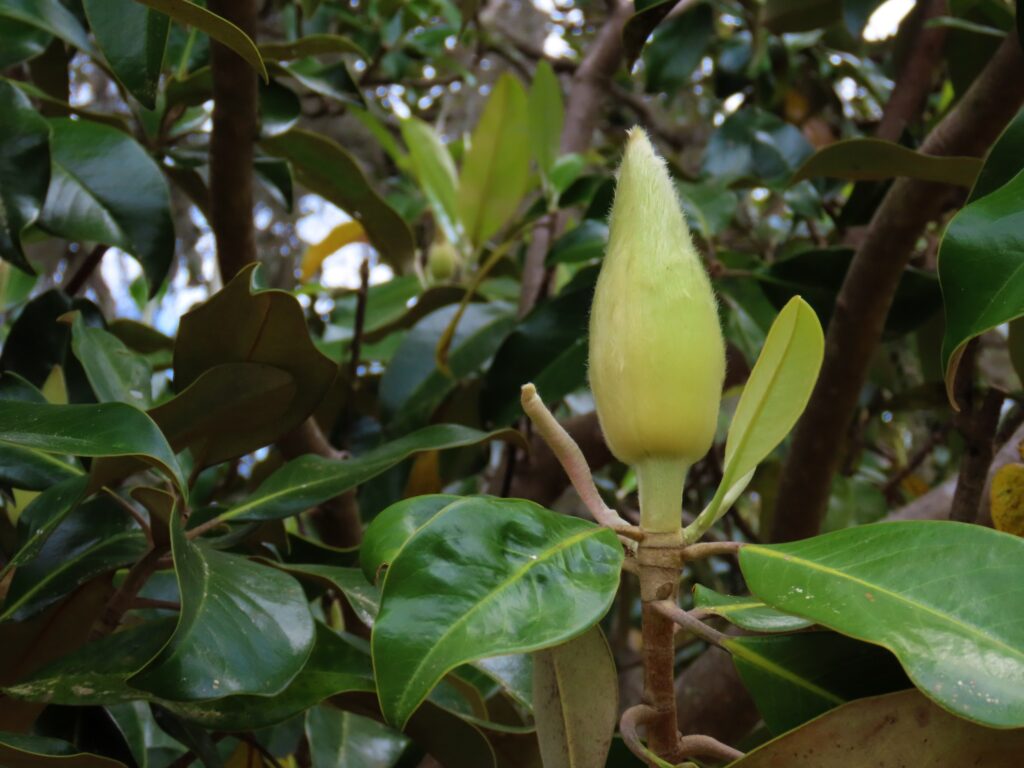

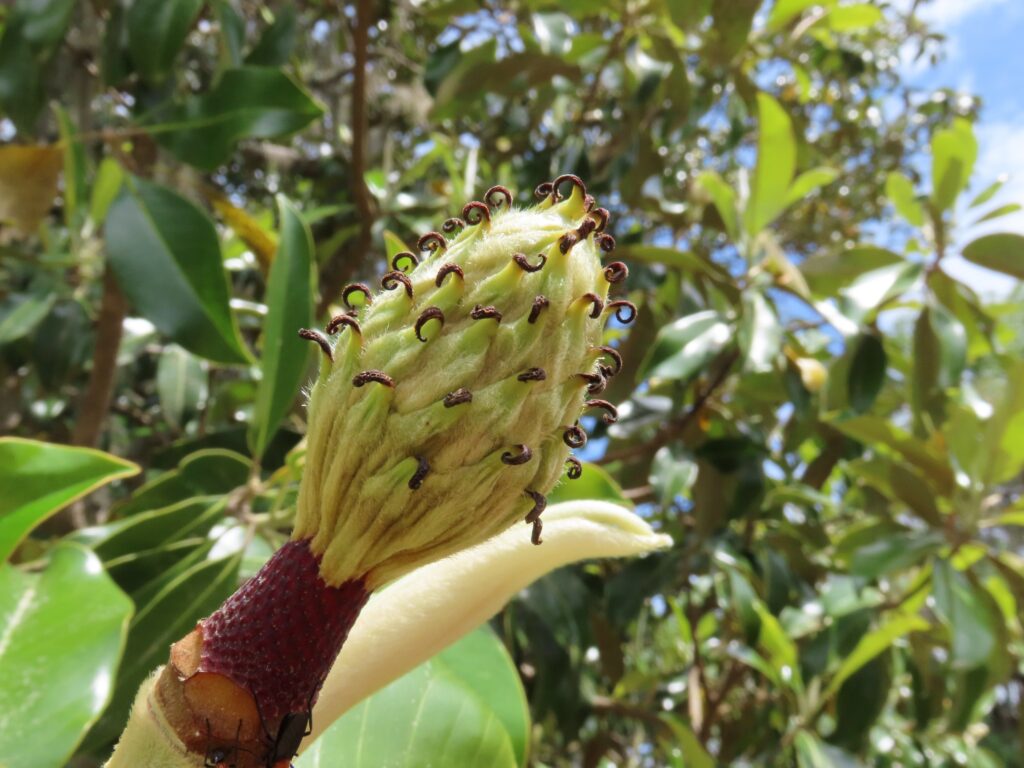

This week for Flora and Fauna Friday we have a grandly floral, fragrant hardwood, the Southern Magnolia (Magnolia grandiflora).
Southern Magnolias are a native to the coastal plain of the South, growing naturally from Texas to North Carolina. Their granite-gray trunks hang high through the understory of the forest where their inky-green leaves devour the fragments of light that trickle down onto their waxy skin. This is a tree that’s playing the long game, much like the Live Oak. Magnolias are not as hardy or long lived as Live Oaks but they make up for it with unmatched crown density. Their giant hand-sized leaves permit no light to pass below them, overlapping like the shingles of a roof. They have the firmness of dry leather, an underside upholstered with fine cinnamon velvet, and a color so deep with green it seems black beside its woodland rivals. At maturity, the abyssal vacuum of light a Southern Magnolia draws beneath permits no competition. That solar monopoly allows a South Magnolia to live a comfortable life beneath the canopy of a forest. However, a life in the interstices of the forest is not the only destiny for today’s tree. Southern Magnolias are equally well-suited for life in the spotlight, quickly reaching an impressive size in full sun. This is their plan from the start. Waiting in the throes of the forest for a neighbor to succumb to the hardships of life, a Southern Magnolia will seize any opportunity to break for the atmosphere. Supplanting the fallen plant in the oligarchy of the canopy and claiming its empire of dirt with the shadow it pours over the land. There it may stand for a century. Uncontested on its homestead of clay and sand. A patch of soil littered with leaves and fruits from years past and nothing more.
Magnolias are an ancient group of flowering plants. The quirks of their archaic origins are best observed in their flowers. Southern Magnolias produce a monstrous bloom more than a foot across. Petals pure from any color mirror the parasols of dark leaves. These china-white bowls bellow out an oppressive soft-smelling sweetness into the passing wind. A scent that saturates the air in an olfactory fog. At the center of the flower sits an egg-shaped structure on a pedestal. This cone-like feature is topped with stout curls of stigmas and skirted by cream-colored anthers, arranged like sticks in the pages of a matchbook. The entire flower is awkward and primitive compared to other flowering plants. What’s interesting is its preferred pollinators. Magnolias do not rely on bees, wasps, butterflies, regular flies, or even bats for pollination. When Magnolias entered the scene, there were no pollinators. So they enlisted the help of unsuspecting beetles. Beetles are rather clumsy pollinators, often damaging flowers in the process of pollination. Thus Magnolia flowers are adapted to be quite robust and resilient. Eventually the matchstick anthers and ivory leather petals fall away and only a warty “cone” remains. This cone grows and hardens into the fruit of the Magnolia, blushing a rosy red across its lime green skin as it ages. When ripe, the fruit splits, offering glistening scarlet seeds to the world that dangle from their cradle by silken threads, swaying precariously in the breeze. Their seeds are coated in an edible layer and eaten whole by birds, who disperse the seeds to off.
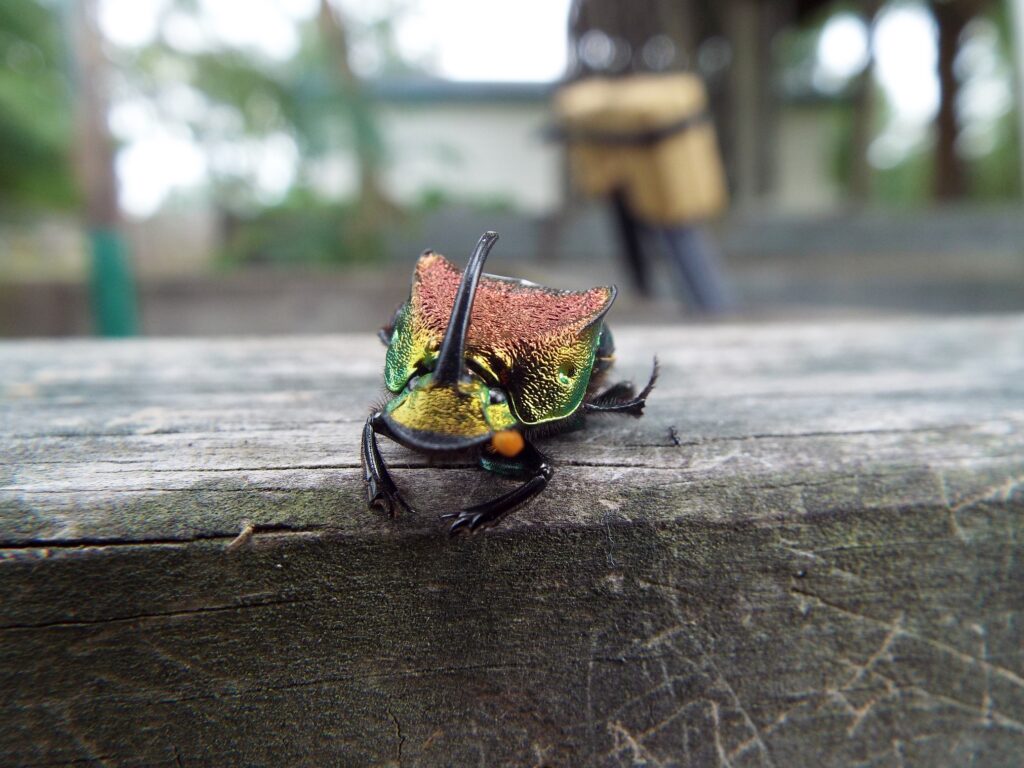

This week for Flora and Fauna Friday I present the prismatic metallic beetle that picks up after your pets, the Rainbow Scarab Beetle (Phanaeus vindex).
The Rainbow Scarab Beetle is an acorn-sized beetle, at about half to three-quarters of an inch, with an overall blocky appearance. It has a heavily textured exoskeleton on the thorax and head, reminiscent of crumbled aluminum foil, as well as ridges running down its elytra, the wing plates. What sets the Rainbow Scarab Beetle apart from the rest, as you may have surmised from the name, is its carapace of many colors. This Beetle has the sheen of heat-treated Titanium. Their black underside plays the backdrop for their rainbow top. Their head and the sides of their thorax are an iridescent brass that shifts to emerald-green, the mantle of their thorax gleams of garnet with hints of amethyst, and their eleytra shine of apatite beset by emerald and brass. If that’s not enough to distinguish this beetle, the males possess a mammoth black horn on their head and a broad triangular plateau on their thorax. Now that’s a handsome bug!
What’s not so handsome is their dietary habits. Rainbow Scarab Beetles are Dung Beetles, a group of Beetles that feed exclusively on animal waste. Both the adults and larvae of this species feed on the same thing. A male and female Scarab will meet each other over dinner. If they hit it off, they’ll each construct a burrow beneath the feast, to act as both cradle and pantry for their offspring. Eggs are laid within these subterranean deposits where their larvae will grow and emerge the following year. Although this habit is unsavory, these colorful critters play an important role in our ecosystems. They are one of many small cogs necessary for healthy nutrient cycling in the environment. When a plant draws nutrients from the soil and an animal eats that plant, those nutrients are transferred into the animal and away from the soil. The excess that is discarded by that animal returns to the soil but, without the help of Dung Beetles, it would either be consumed and dispersed again by flies or remain in the top soil were it can easily be washed away by rainwater runoff. Runoff from animal waste into river systems is a huge concern for water quality, even here on Edisto Island. Dung Beetles help to sequester this waste by burying it deep in the soil. This prevents nutrient runoff. Additionally, it helps to improve soil quality by moving nutrients below the topsoil and reducing soil compaction from the burrowing action of the Beetles.
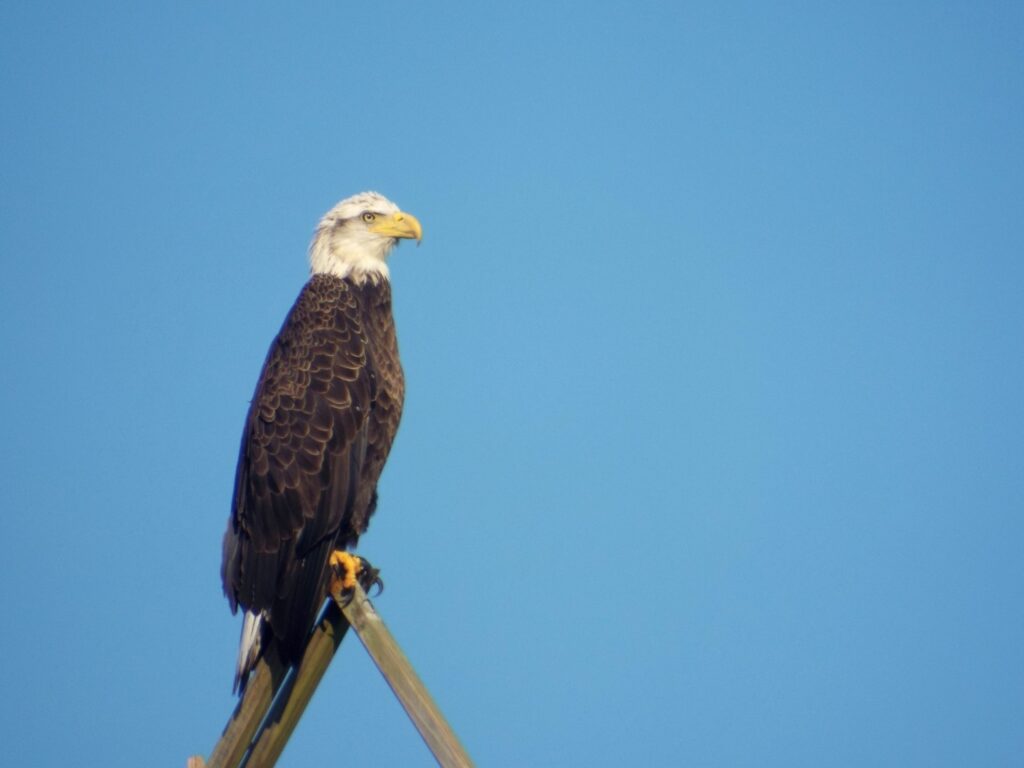
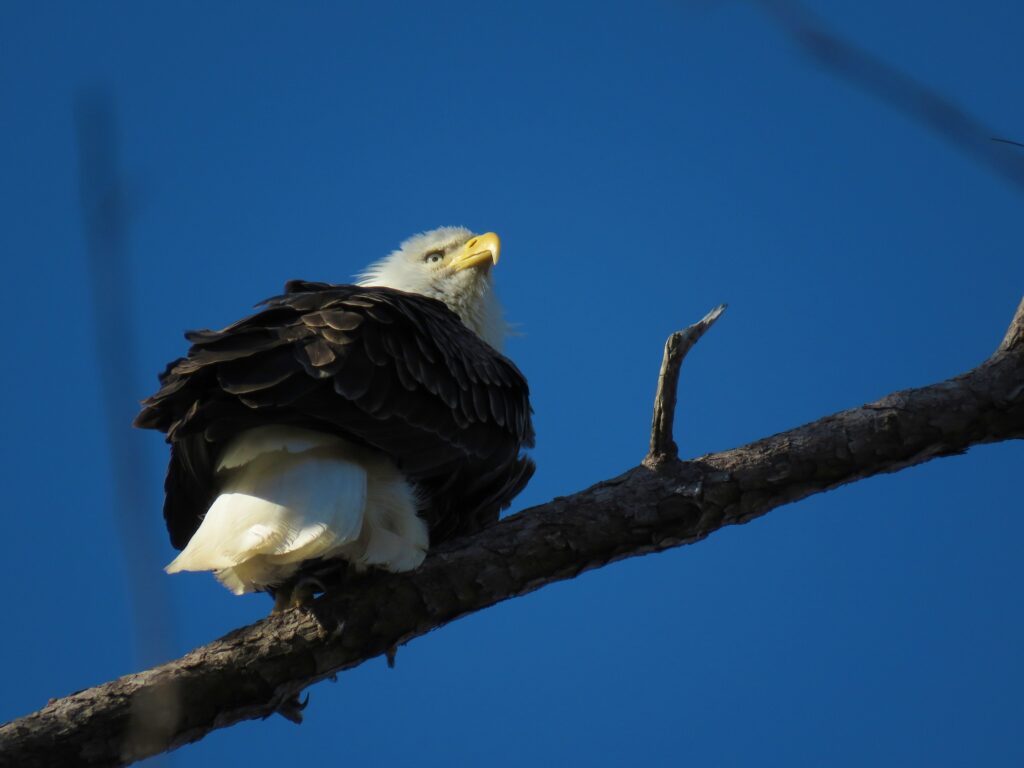

This week for Flora and Fauna Friday we have the proud symbol of freedom and American exceptionalism, the Bald Eagle (Haliaeetus leucocephalus).
The Bald Eagle is the largest raptor in South Carolina. It’s an unmistakable and profound bird to behold. Their shadowy wings, held wide and true, spread eagle across the sky eclipse the clouds. Their head crowned a snow-white summit and tail a trailing cirrus cape. Perched on golden legs anchored by toes tipped with coal-black sickles. Piercing yellow eyes, so sure and resolute, bore out abreast a stout hooked bill of similar shade. A straight posture, stiff held wings, and expressive face radiate an aura of pride and self-assured confidence.
Bald Eagles build massive nests near water in the crooks of tall, mature trees. The birds mate for life and reuse the same nest year after year, until either the tree collapses or the nest is stolen by a Great Horned Owl. These nests can exceed 10 feet in width and weigh over a ton. Bald Eagles usually hatch two chicks each year and it takes a bird 5 years to reach maturity. Bald Eagle are carnivorous but primarily piscivorous. They mostly eat fish caught from rivers or lakes but are quite fond of waterfowl, rabbits, rodents, and carrion too. They are particularly fond of American Coots (Fulica americana), a strange and social waterfowl that is most closely related to Rails. They can also commonly be spotted dining on fresh carrion with Turkey Vultures.
Bald Eagles secure their prey using their awesome eyesight, robust talons, and sheer bulk. Eagles have the best long-distance vision of any animal. They can see roughly eight times farther than a human and can discern a far wider spectrum of color than us. This allows them to identify and focus on camouflaged prey at a distance of two miles. That’s about the maximum distance an unaided human eye, in ideal conditions, could identify a human silhouette as something other than a speck. Realistically, it’d be about the distance you could identify a horse. (For visualization, two miles is the distance from the top of the McKinley Washington Jr. Bridge to Jehossee Island, which is along the South Edisto to the west. Now imagine trying to a rabbit from there!) After an Eagle hones its laser focus onto its prey, it approaches low, swings its legs forward, and simply scoops up its dinner using its momentum and curved claws like grappling hooks. Their considerable size lets them take larger prey than most raptors and allows them to bully Ospreys and Foxes into surrendering their kills. They’ve even been trained by falconers to attack and disable drones!
As you may know, Bald Eagles almost went extinct. They were one of the many victims of rampant insecticide misuse in the middle of the 20th century. Chemicals like DDT were sprayed on crops to kill agricultural pests. These pesticides were miraculously good at that job. However, the chemicals did not biodegrade and were commonly misused by farmers at extreme excesses. When it rained, DDT was washed into streams and rivers by rainwater. Here the chemical was absorbed by microscopic bacteria and plankton. These plankton were the basis of the aquatic food chain and were themselves consumed by insects and minnows. Who were eaten by small fish, that were eaten by larger fish, which were then eaten by Bald Eagles. At each step in this food chain the concentration of DDT in the animal increased exponentially. The chemical accumulated in the animals’ flesh over the course of their lifetime, until it reached lethal levels for Eagles. DDT has the interesting side effect of inhibiting the proper development of bird eggs, making the shells brittle. This leads to the eggs being crushed during incubation. Bald Eagles were large birds that were slow to mature and sat atop an aquatic food chain. Because of this, they were hit harder than any other species by the effects of DDT. Luckily, through rigorous government protection campaigns and the banning of DDT, the Eagle has made a full recovery and has been removed from the endangered species list.
Nowadays, Bald Eagles are safe from pesticide contamination but face a new more surreptitious threat in the Southeast called Avian Vacuolar Myelinopathy, or AVM. It’s a nervous system disease that affects birds. It’s caused by a toxin found in a certain species of cyanobacteria. (Cyanobacteria are an immensely diverse group. They are photosynthetic and found in every body of water.) How does this toxin get into the Eagles? It gets there from the American Coots I mentioned before. How does the toxin get into the Coots? An invasive aquatic plant called Hydrilla. The species of cyanobacteria at fault grows on the surface of the Hydrilla, whose leaf shape promotes their vigorous growth. Far more vigorous than on any native vegetation. The Coots scarf down the Hydrilla, along with the cyanobacteria, and develop AVM. This disease causes muscular discoordination, leaving the birds unable to fly or swim well. Coots congregate in large rafts that are often over 100 birds strong. They use their numbers to confuse predators. Their densely packed numbers make it hard for an Eagle to focus on one specific bird and allows the Coots to dart out of the way at the last second. When a Coot develops AVM, it can no longer keep up with the raft. The sick Coot falls behind and gets singled out by the Eagle. Since they’re so easy to catch, Bald Eagles in AVM affected areas are preferentially eating sick Coots. Just like DDT, this toxin bioaccumulates and every AVM stricken Coot the Eagle eats intensifies the symptoms, until the Eagle succumbs to the same fate. Hydrilla is a non-native plant that takes over lake systems. Its harmful effects on the environment extend far beyond just Bald Eagle deaths. SCDNR is actively and feverously working to destroy the species anywhere it occurs in the state.
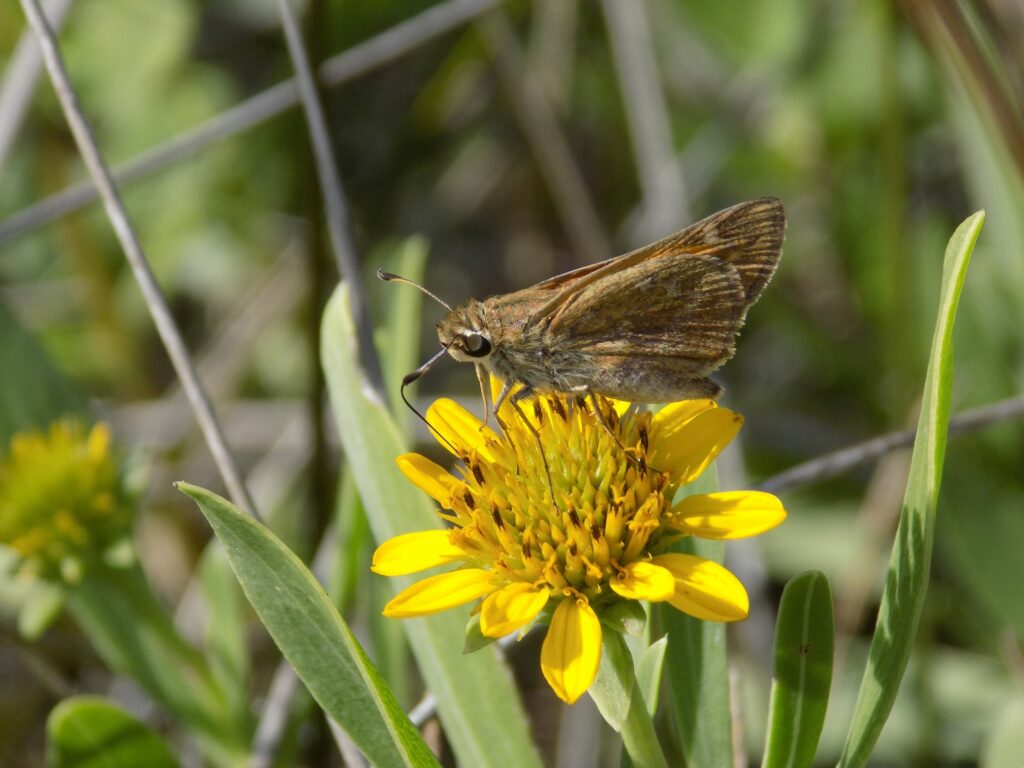
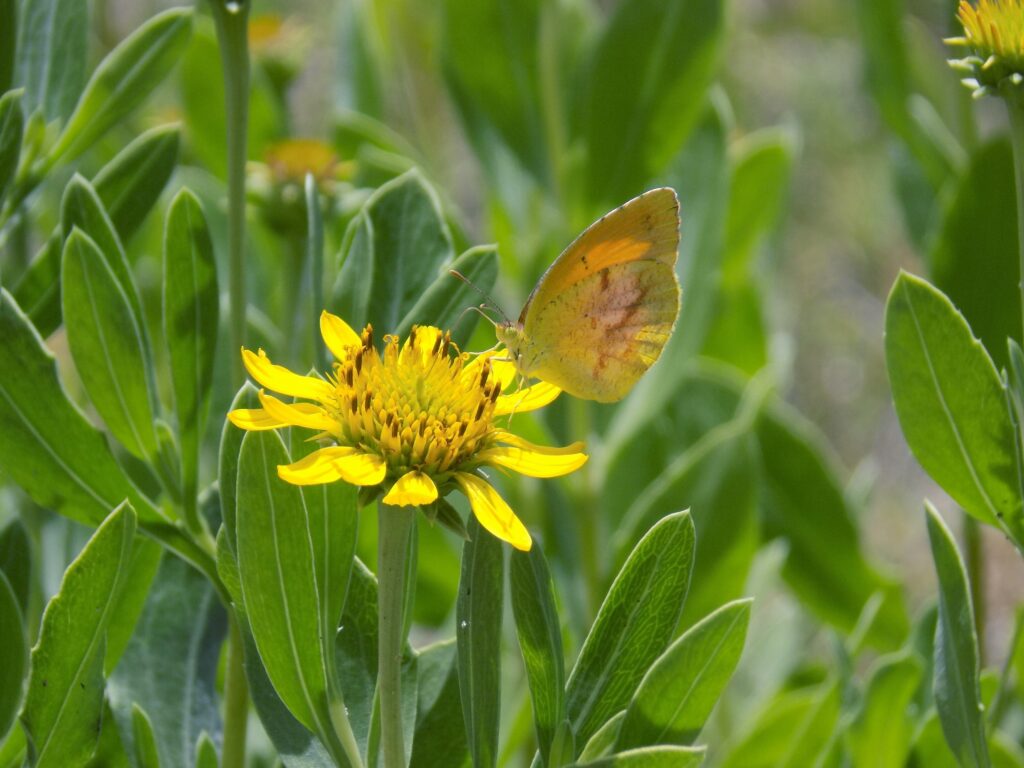
This week for Flora and Fauna Friday we have a salty succulent shrub that’s loved by bugs, Sea Oxeye (Borrichia frutescens).
Sea Oxeye is a member of the Aster family found on beaches, hammock islands, causeways, and high marsh habitats. It stands up to three feet high on a straight and gnarled perennial stem in the company of its clonal neighbors. Sea Oxeye grows in dense ribbons, bordering the coast of saline systems. Its supple stem and succulent silvery evergreen leaves are packed with water. This allow the plant to survive the harsh, hot climate in the sandy sodic soils of southern coasts. The salts of the saturated soil and periodic tidal inundation act to dry out the plant. So even though they may be growing in soggy soils, the plant nonetheless needs these drought tolerant adaptations.
Sea Oxeye flowers from spring through summer and is a sought after source of sugary nectar for many insects. Butterflies, Blister Beetles, and Bees abound down the corridors of yellow paved by our Oxeye. Their bloom is sunflower-like and not unsubstantial, with a wide disc ringed in rays of saffron. The flowers are prolific and robust and yield a dry spiny fruit. The fruit is firm and woody with a dome of thorny divisions. Their pincushion-esque fruit protects the profusion of seeds inside. Beneath each needle is seated a single seed. With wind and waves the stems are shaken and snapped, scattering the seeds to sow in the sand below. Sea Oxeye’s sparse and smooth-sided stems create small-scale savannas beneath their stratified canopy. Within this minute woodlot a myriad of marsh critters can conduct their day’s business safe from their skyward predators. Fiddler Crabs, Clapper Rails, Marsh Wrens, Marsh Rabbits, and Mink scurry, slalom, and sidle their way between the trunks whilst Rice Rats and Seaside Sparrows snack on the Sea Oxeye and Spartina seeds scattered beneath.



This week for Flora and Fauna Friday we have a favorite food for baby butterflies, bumblebees, and biting bugs. This week we’re admiring Butterflyweed (Asclepias tuberosa).
Butterflyweed is a native Milkweed that’s commonly found in the sandy soils of open pine woodlands. Butterflyweed produces a deep, thick taproot, much like a carrot, that allows the plant to proliferate in dry sandy soils and tolerate frequent fire. The plant is a short and compact perennial with narrow, emerald leaves. It blooms in late spring and early summer, producing a plateau of tiered orange flowers. The flower of a Milkweed is unique and complex. Upon examination, the petals are the five downward facing structures at the bottom of the flower. Above these sit five horns, each surrounded by a petal-like hood. At the bottom of these hoods are the nectar glands. Between these horned hoods is a fused and elongated set of five stigmas. At the top of this female structure are the male anthers. This whole central structure is called the gynostegium. Another quirk of Milkweed is that their pollen is not in loose grains. It’s in a sack of pollen called a pollinium. The pollinium is then attached directly to any visiting pollinators. This pollen sack must then be delivered to another flower by the chosen insect. Bees and Beetles are the preferred pollinators of Milkweed. This picky pollination technique explains why Milkweeds so often fail to fruit.
Milkweed gets its name from its poisonous, milk-white sap. This sap is a latex full of toxins that cause cardiac arrest when ingested. The sap is foul tasting and exudes quickly, filling the mouth of would be predators. As you likely know, Milkweeds are the host plant for the Monarch butterfly. Monarchs make use of the Milkweed’s namesake sap to protect themselves. Milkweed is also a favorite food of the creatively named Large Milkweed Bug (Oncopeltus fasciatus). The Milkweed Bug uses its sharp proboscis to poke into a Milkweed plant and suck out the heart-stopping sap. From this ichor the Bug gains the same poisonous armor as the Monarch, which both advertise with bright orange and black colors.
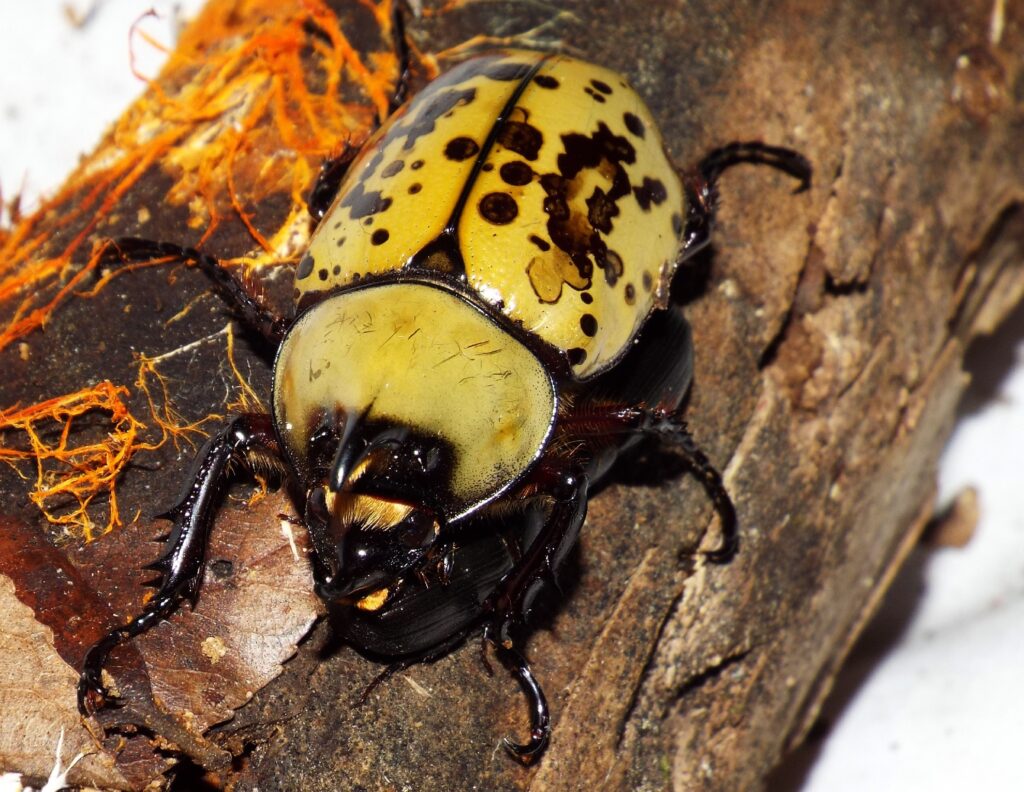
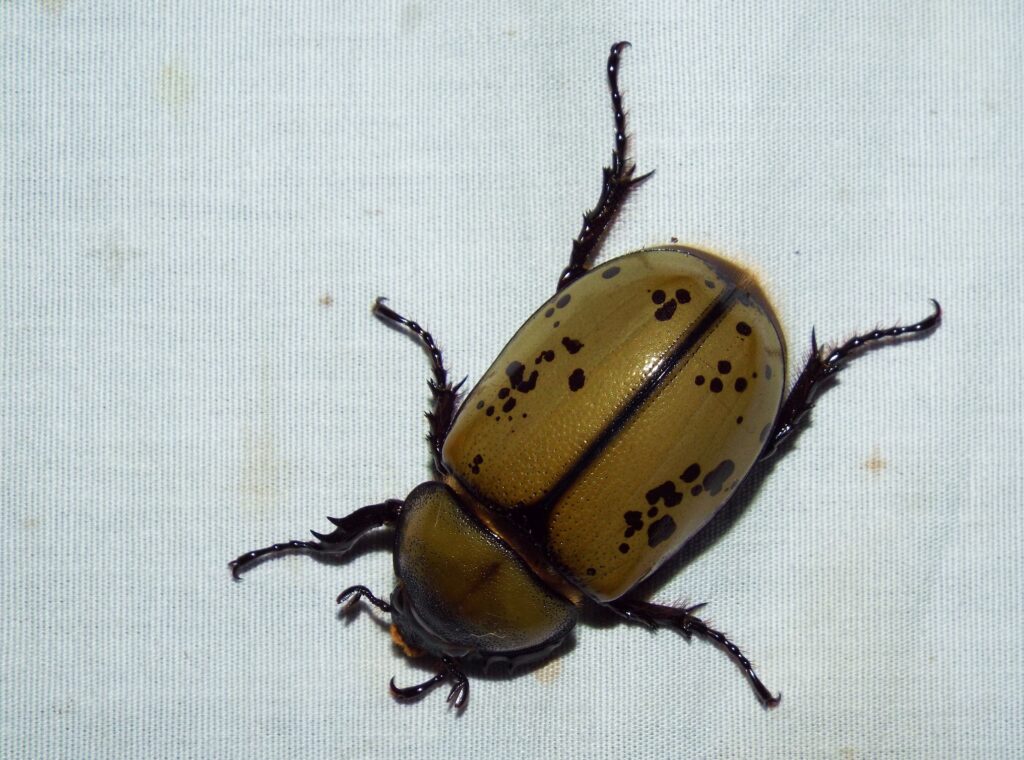
This week for Flora and Fauna Friday we have our biggest beetle. Today we’re talking about the Eastern Hercules Beetle (Dynastes tityus).
The Eastern Hercules Beetle is the heaviest Beetle in North America and this substantial insect measures over two inches long. Their glossy olive exoskeleton is ink spotted, trimmed black, and gilded with fringes of golden hairs. Their bulk is supported by thin, shining-black segmented legs. The oval body of the Hercules Beetle has considerable heft and volume for an insect. They’re a wonder to observe in the hand. Males of this genus are adorned with horned heads. His thorax is tall and elongated, forming a robust, hooked projection of the pronotum called a pronotal horn. A similar and reciprocal projection is found on the head. These paired projections create a facial pincer with a crab-claw-esque construction. Male Hercules Beetles use their horns to compete for mates against other males. Two males will lock horns and attempt to lift and suplex the other beetle, with their face. It’s a pretty radical lifestyle.
Eastern Hercules Beetles start life as an egg laid within the rotting log of a once mighty hardwood. That egg quickly hatches into a larva, called a grub. The grub grows quickly, reaching four inches in length during the two or more years it spends as a grub. The grub will pupate before metamorphosing into our substantial shiny summer beetle with a wrestling obsession. The Eastern Hercules Beetles, much like Pileated Woodpeckers, require mature and healthy hardwood forests to survive. They feed in the rotting logs of large hardwood trees and a steady supply of big dead trees is needed to maintain their population. Beetles as a whole are an important node in the forest food web. They decompose fallen logs, returning the nutrients trapped within to the surrounding environment and encouraging new plant growth. These beetles also serve as an important food for other wildlife. The grubs are a sought after delicacy for Raccoons and Woodpeckers.


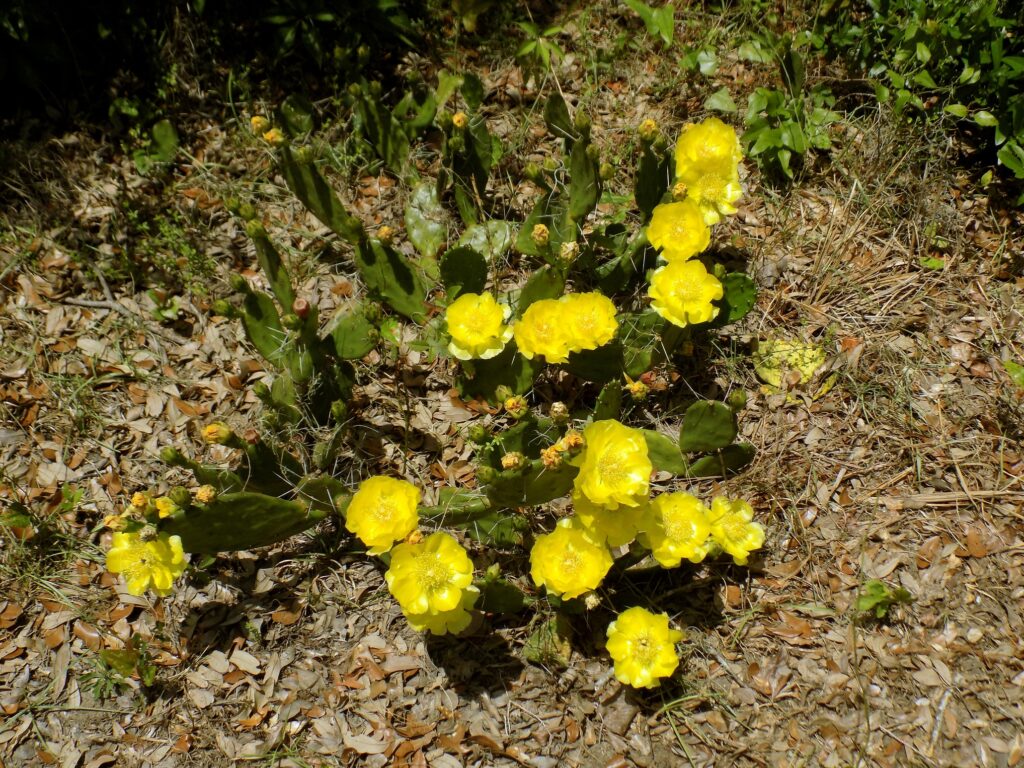
This week for Flora and Fauna Friday we have sandy, spiny succulents. The week we’re talking about the Prickly-Pear Cacti (Opuntia spp.).
In South Carolina, the Prickly-Pears are our only representative of the Cactus family. On Edisto Island, three native species of Prickly-Pear exist. The Erect Prickly-Pear (Opuntia stricta) is a tall cactus with large “pears.” You’ll most often see this cactus as an ornamental planting but it can show up naturally along the beach. The Cockspur Prickly-Pear (Opuntia pusilla) is a small cactus that can be found lying atop the sand, sunbathing between the beach dunes. It has small, almost cylindrical pears and a tangled, prostrate growth form. The Eastern Prickly-Pear (Opuntia humifusa) is the most common Cactus you’ll encounter on Edisto Island. It’s a smaller cactus that can reach 18 inches in height and tends to fall-over as it grows. Our Prickly-Pears bloom in late spring and early summer. Their glaring solar-yellow flowers are large, showy, and loved by Bees of all sizes. These flowers peel away to leave a cratered pear behind. Over time this pear reddens and ripens into the Prickly-Pear fruit. Their fruits are edible but not readily accessible as I’ll explain later.
All our Prickly-Pears love sandy soil and full sun and all are common in dune ecosystems. The Eastern Prickly-Pear is also quite common on the sandy hills near tidal river systems. Cacti are able to survive in hot, dry, sandy environments as perennials because they practice a specialized form of photosynthesis and can store a large volume of water in their stems. During the day, the Prickly-Pear closes its stomata, the microscopic pores across the plant that allow it to breathe. This stops the Cactus from losing water through these pores due to evaporation. However, it can no longer breathe in the Carbon-Dioxide it needs to create sugars. With Crassulacean Acid Metabolism Photosynthesis, or CAM for short, the Cactus can suck in Carbon-Dioxide all night long and store it until the sun comes up. This allows the cactus to breathe all night long and soak up sun all day, without drying up or starving in the process. These adaptations permit Prickly-Pears to survive in even the most arid of conditions.
Prickly-Pears have an interesting physiology. The “pears” that you see are not leaves. They’re the stem of the plant. This stem is where the plant stores water and carbohydrates and where it conducts photosynthesis. So where are the leaves? A cactus, with its water and sugar rich flesh, is an enticing target to herbivores in any arid ecosystem. As a defense against hungry mouths, Cacti have reduced and repurposed their leaves into devilish spines. These spines are as stiff and sharp as a needle and finely serrated. In addition to the spines, Prickly-Pears produce an even more insidious defense called glochidia. Glochidia are minute but extremely sharp hair-like spines found in dense clusters at the base of the larger spines. These Glochidia are microscopically barbed. Upon contact with skin, they pass through effortlessly. Their barbs make them impossible to remove and cause immense irritation. If you’ve ever worked with insulation, it’s like having fiberglass under your skin but worse. As such, Prickly-Pears are best appreciated at a distance!


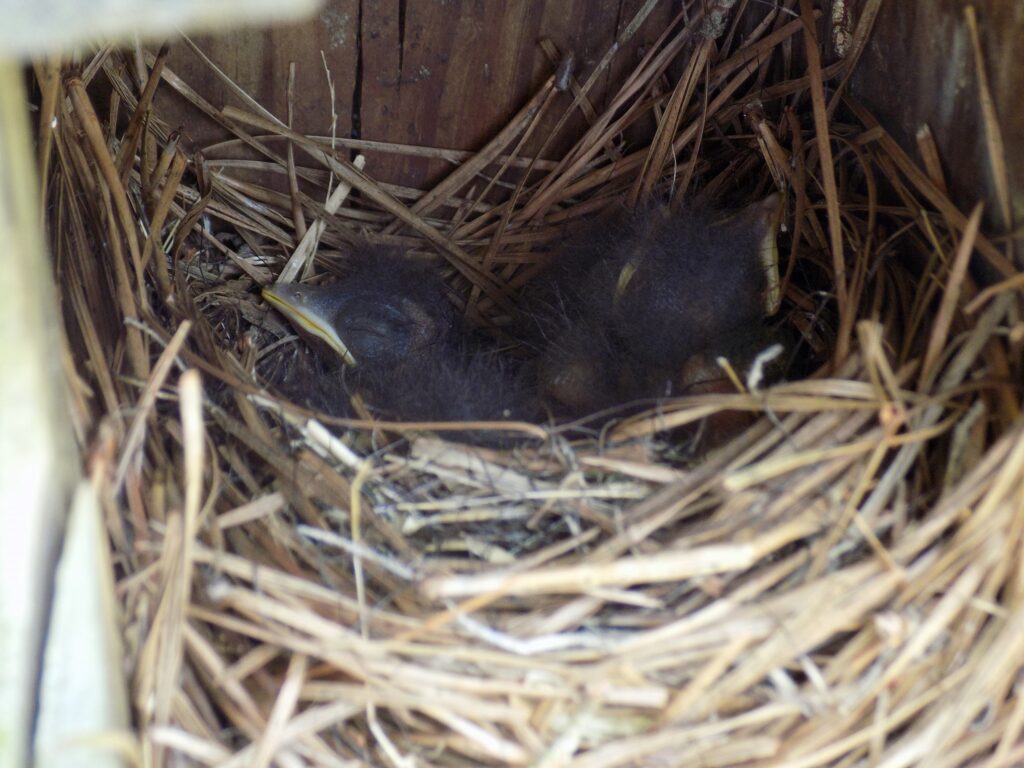
This week for Flora and Fauna Friday we have the cerulean songbird of the savanna, the azure agrarian avian, the Eastern Bluebird (Sialia sialis).
As I’ve touched on before, Eastern Bluebirds are a member of the Thrush family. Thrushes are stocky insect eating birds with large eyes and a narrow, pointed bill. Bluebirds fit this description but are more petite than other Thrushes. Their bill is thinner and they’re size is smaller but they maintain the prominent peepers. Both males and females are 6 to 8 inches long with a rusty red breast, dark beady eyes, delicate slate legs, and a cloak of that namesake’s shade. Females sport a cowl of aluminum gray running under patinated wings into a powdered copper blue fan of tail. Males are not so subtle and flaunt feathers of a rich sapphire abroad their back and a barrel-chested breast as red as Carolina clay. The red of the breast is a product of carotenoids. Carotenoids are red pigments produced by plants. Bluebirds acquire these pigments from eating insects who were eating those plants and the birds incorporate those compounds into their own bodies. Bluebirds feed on a wide array of arthropods. They can often be spotted hawking grasshoppers, plucking worms, biting beetles, and swallowing spiders. This third-hand pigmentation acts as a proxy for individual health when Bluebirds select a mate. A well fed bird is healthier. A well fed bird is redder. A well fed bird eats more pigment filled bugs. Or so a bird can infer. The blues of these birds are not any kind of pigmentation but the result of a polymer microstructure within the long dead cells of the feathers themselves. A protein lattice that’s mere shape induces the scattering and refraction of only blue light. An illusion of beauty.
Bluebirds were not as numerous and widespread as they are today. Their populations were sharply declining in the mid-1900s due to a lack of nesting habitat, competition for nesting habitat, and decreased nesting success. Bluebirds nest in cavities and, in order to have a cavity, you have to have something to carve a hole in. Bluebirds reuse old Woodpecker nests or expand feeding divets left by Woodpeckers on dead trees. Their natural habitats are open grasslands with high disturbance rates and trees mixed sparsely throughout. Habitats such as pine savannas and scrub barrens. The lumbering of Longleaf Pines in the 1800s removed a lot of their natural habitat but forest clearing for agriculture produced even more. However, as farms became larger and mechanized, the wind breaks and woodlots vanished, taking the Bluebirds with them. The introduction of invasive House Sparrows and Starlings from Europe created nest competition and these more aggressive exotic birds overwhelmed nesting Bluebirds. The use of the insecticides, like DDT, on farms continued the trend, killing the arthropods the birds depended on for food and lacing bluebird nests and the insects that did survive with the bio-accumulating toxin. In the 1960s, Bluebird nest box campaigns gained widespread public momentum and the use of DDT and similar insecticides was banned. Eastern Bluebird populations rebounded with staggering momentum. Nowadays, Eastern Bluebird populations have totally recovered and are still growing. They’re now even are more numerous and widespread than in pre-colonial days!



This week for Flora and Fauna Friday we have a shrubby medicinal plant with impressive floral displays. This week we’re looking at American Black Elderberry (Sambucus canadensis).
Elderberry is a large shrub partial to wet, sunny soils and common within the ditches along our Scenic Byway 174. Elderberry can grow to 12 feet high with dense intermingled foliage. Leaves are oppositely arranged and pinnately compound. Stems are green transitioning to tan, with a fine warty texture. Elderberry is a deciduous perennial and, despite its considerable size, dies back to its roots after a hard freeze. The stems of Elderberry are hollow and brittle. These tubular trunks provide a refuge from the cold to insects and spiders over the winter. (With a mild winter like this last, Lowcountry shrubs have survived in entirety.) Elderberry blooms from spring through summer, peaking the end of May. Flowers are small with five ivory white petals and presented in large spreading clusters, hundreds at a time. Each Elderberry bush produces dozens of these flower clusters at once, littering the roadsides with frothy flowers. These flowers are a beacon for pollinators, beckoning scads of small insects, like the Lovebug. The flowers fall away with age, leaving nothing but gleaming pearls of saccharine black. Through summer, the boughs of Elderberry bow from the burdening of berries. The petite fruits are a banquet for the usual suspects. Mockingbirds, Raccoons, and Cardinals gorge themselves on this fare of sweet treats, ferrying the seeds within their bellies. As these critters wander on wing and claw, they discard the remnants of past feasts wherever they chance to be. With a winter’s rest, new Elderberries coil forth afar.
Elderberries are edible for humans too. However, the seeds are mildly toxic, so the berries should be boiled and strained first to avoid indigestion. Elderberry juice has been used for centuries in traditional medicine as a cold and flu remedy and the berries are fairly nutritious. Research into the plant’s medicinal properties has been scarce but the few studies that exist appear to corroborate the claims of traditional medicine.